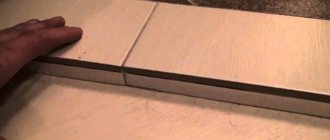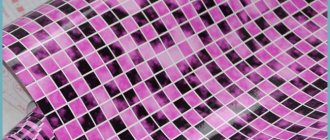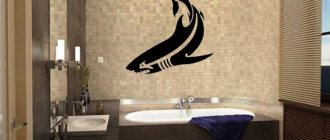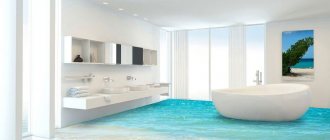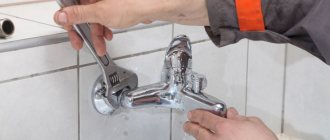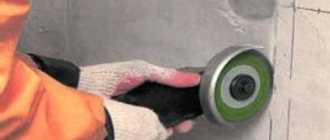Proper lighting in the bathroom decorates the interior and creates a pleasant atmosphere. Increasingly, LED devices are used when organizing bathroom lighting - they are easy to install, safe and cost-effective.
Before you begin installing the lighting, you need to learn more about the specifics of electrification of wet rooms, study electrical safety rules, draw up a wiring plan, select lamps and other elements of the system. All these points are described in detail in our article.
In addition, we described the procedure for arranging LED backlighting and outlined the main stages of installation and connection of the LED strip.
Types of lighting equipment
Types of lighting
Today there are three main large groups of lighting devices:
- Filament elements. You are very familiar with these lamps; they have been and are still used in households and industry. Their advantage is their relatively low cost and ease of installation. But they cannot boast of a long service life.
- Fluorescent lamps used to be represented by long elements that were installed in special lamps. Today these are economical lamps that do not require a special approach to installation.
- LED technology began to gain popularity relatively recently. Its advantages deserve special attention.
Photo examples in interior design
Photos of interior solutions in the bathroom are available in the gallery.
You can diversify your interior using any type of lamps. However, it is important to carefully study the safety precautions during their installation and operation. The lamps in them must be resistant to temperature changes and protected from water, dust, and debris.
Why LEDs
LEDs
At its core, an LED is a semiconductor that is powered by direct current and has high performance at low power. In addition, we can note the different color temperatures that LEDs can have. This can be a cold glow - 4000 K and above, as well as a soft glow - 3200 K and below. No other type of emitter can compare in any of the listed characteristics.
Cylindrical
LEDs come in three main types:
- Cylindrical - have minimal consumption, but light output suffers. They are most often used in instrument panels, illuminated switches, handle space markings, night lamps, etc.
- SMD LEDs are new in this area. They are designed for installation on a special driver board. This type is very effective. One element with a power consumption of 1 W can have an output of 10 W or more. It turns out that 10 such semiconductors can replace a 100-watt light bulb and at the same time consume 10 times less electricity.
- RGB LEDs are a subtype of the previous option. Their special highlight is that they can change the color according to your desire in four options: red, blue, green and white.
SMD
The service life of these elements can be more than 10 years.
Bathroom zoning
Bathroom zoning
Backlight can be of two types:
- main;
- decorative
Bath lighting
The main one makes it possible to form a general picture. The locations of this type of lighting are:
- mirror;
- bath or shower;
- place near the bathroom.
Ceiling
Decorative lighting emphasizes any details, expands the room, creates a feeling of airiness and a certain atmosphere. The places of its installation are:
- floor;
- ceiling;
- niches in the walls;
- contour of a bathtub or shower;
- shower head or faucet;
- shell rim.
Watering can lighting
Mixer lighting
Main backlight
Before planning the purchase or placement of lighting fixtures, it is important to first decide on the layout of the bathroom. When you already know where all the plumbing units will be located, what their height and outline will be, then you can start choosing lamps and fixtures.
Mirror
A mandatory location for installing sufficiently bright lamps is mirrors. It is important that the lighting is uniform and that the shadow is not cast on the face from one side. Two lamps, which will be located at the same distance, will help achieve this. They can use LED lamps equivalent to 40–60 W. When choosing, pay attention to elements of a neutral glow, then the skin will not acquire a pale or too yellow tint. It’s good if the glass is frosted with soft dispersion, then it won’t dazzle or strain your eyes. There is another option - using LED strip. If the mirror is located above the washbasin, then it is good if the tape has an IP68 protection standard, then no splashes or drops will harm it. It should be placed along the entire perimeter of the front part. When mounted behind a work surface, it acquires a decorative character, because part of the flow is lost. To prevent the rays from shining directly into your eyes, it is better to cover it with an opaque aluminum frame, which will direct all the light into the mirror. An excellent option would be to purchase a ready-made structure with a translucent transparent layer.
Bathroom lighting options
To ensure sufficient safety when in the bath or shower, it is also important to install good lighting. Here you can use one or more ceiling lights. If the ceiling height is small or the bathtub is on a pedestal, then an excellent solution would be point elements that are installed almost in the same plane with the surface. They can be used to mount any suitable LED lamps. It is advisable that they also be covered with diffusers, then the eye will not have to get used to such conditions for a long time. To illuminate the space near the bathroom, you can use the same options as for the bathroom.
Ceiling spot lighting
Note!
Arranging sources in such quantities is advisable if the bathroom is large enough. If space is limited, then you can get by with one ceiling lamp located approximately in the middle or several spotlights that will be evenly distributed over the entire ceiling area.
About grounding spotlights
If you look at almost any modern spotlight, you can see that the manufacturers have equipped it with a grounding terminal. But these lamps are located at a distance from water sources. Why do they need to be grounded? Perhaps this precaution will be unnecessary?
Bathroom safety measures should not be limited to grounding only in the lighting circuit. This is a comprehensive method of protection that applies to all electrical appliances located in the room.
A humid environment is dangerous because electrical charges in it can spread not only along electrical wires, but also along condensation-covered floors, as well as along damp walls and ceilings. They are also well transmitted along load-bearing profile structures that are used when installing suspended ceilings.
If you neglect the grounding of spotlights, then when the phase gets wet, the charge can spread along the profile, and then along the wetted wall. If a person is taking a shower at this moment, he may accidentally lean against the wall or simply touch it with any part of his body. In this case, he will receive an electric shock that will pass through his body and go to the floor.
It is possible that an electric shock will only be felt as a slight tingling sensation, which is not fatal, but still unpleasant. But you can also get a full blow with unpredictable consequences. To prevent this from happening, grounding protection should be used.
Decorative lighting
Lighting in niches
- Decorative lighting is just the option that will allow LEDs to show their full potential. You already know where it can be installed, now we will give practical tips that will make the lighting more effective.
- If you decide to emphasize the line of the ceiling, then it is better to hide the LED strip in a recess. This planning should be done before any renovation work is carried out. To expand the overall space, place the lighting fixture along the large outer perimeter of the entire bathroom. Want to lift it up a little? Then place the tape in the niche, which will be located in the central part.
- An excellent solution is lighting that will be located in wall niches. The basic rule for lighting the middle zone: the flow must be directed away from you so that those in the bathroom do not experience discomfort.
Along the contour of the bathroom
A sealed LED strip can simply be placed below the contour of the washbasin, as well as the bathroom. After this procedure, it seems that they are floating in the air, in addition, it will be better to see where to step.
- In order to illuminate the floor, you can use several options. If you make grooves, you can place duralight in them, and cover the space on top with glass or a plastic cover. There is another option - sealed recessed lamps.
- An interesting option would be LED dots, which are located along with ceiling lights. You can choose a different glow color from the main one to get a pleasant combination.
- Some fixtures can be installed directly on the bottom of a jacuzzi, bathtub or shower. When you lie in such conditions, the sensations are indescribable.
- Use circuit breakers and LED strip lights in cabinets. It will operate when the door is open.
- Duralight can be attached to the rim of the bottom of the furniture, which will add its own special flavor.
Along the contour of the cabinet
Note!
If you want to expand the space, use a white glow. If you would like to emphasize airiness, then blue or light blue will do. To avoid feeling depressed, use less red light.
Comments:
Korban
There is no particular need for a “protected” bathroom tape. Firstly, the voltage supplied to it is only 12 volts, which is imperceptible even in the case of direct contact with a person, and secondly, the contacts in the tape are made of non-oxidizing metal, so the effect of moisture on them is negligible.
Stepanych
Korban, all this is true, but only when it comes to places without much exposure to moisture. For example, it is better to illuminate the mirror above the sink with a protected version of the tape, because... there is a high probability of splashes on unprotected contacts. And we are no longer talking about safety for humans, but about the fact that from such splashes (as well as from wiping these splashes) the tape becomes unusable within six months to a year.
Sverdlov
Good article, but I wouldn't rely on the strip as the main light source, even in the bathroom. It illuminates too weakly, and the flickering can hurt the eyes. Like lighting a mirror or cabinets - that’s it.
Leave a comment Cancel reply
Related Posts
Stretch ceiling lighting with LED strip - features and installation procedure. Video.
Do-it-yourself LED lighting for a dacha or country house
Aesthetic kitchen lighting with LED strips
The device, technical capabilities, and scope of application of LED strip 3528
Some installation tips
Plan your lighting before finishing
There is nothing difficult about making this kind of lighting with your own hands. To do this, just follow a few simple steps:
- Plan before finishing. Think carefully about where all the niches will be located, because it will be very difficult to make them afterwards.
- Buy elements with moisture protection.
- It’s good if the devices operate through a step-down transformer.
- All connecting nodes must be well insulated.
- The best option is if you provide a separate circuit breaker with an RCD for the bathroom.
- Place the step-down transformer in an adjacent room so that moisture does not damage it.
- Use your imagination.
We tried to outline for you the basic methods of using LEDs for bathroom lighting. It is impossible to present all the options in one article, so we ask you to share your ideas in the comments.
A few design tricks
There are several design techniques that will decorate a bathroom of even the most modest dimensions. Additional light and space in the room will be provided by a false decorative window. To do this, you need to place a light source behind the frosted glass representing the window. With the help of moisture-resistant paints “outside the window” you can recreate any landscape that is pleasing to the eye.
A false window always looks very impressive. You can depict intricate frosty patterns or a pleasant summer landscape on it.
Of course, there is no point in using everything in your bathroom at once: you need to combine different types of lighting, guided by a sense of proportion and your own taste
Original and safe lighting for some bathroom elements can be done without connecting to the mains. For this purpose, special devices are used - a light tap and a light shower: with their help, water jets are illuminated. Moreover, as the temperature of the water changes, its color will also change. This creates an amazing romantic atmosphere that will not leave anyone indifferent.
